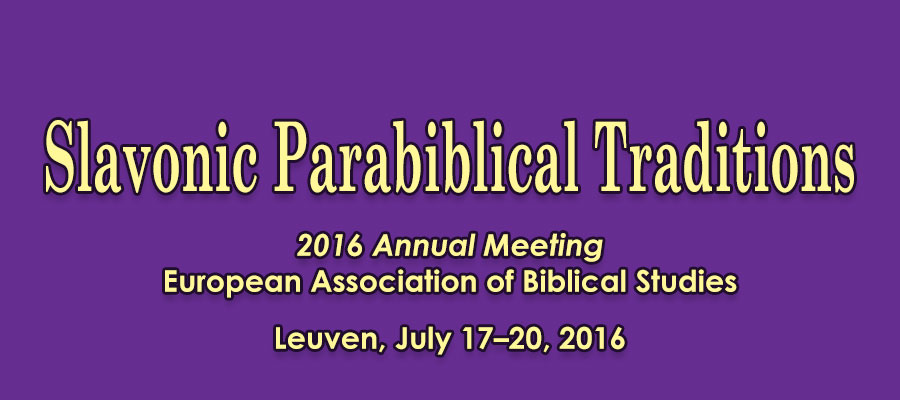The 2016 Annual Meeting of the European Association of Biblical Studies provides the opportunity to present results from the on-going GIF (German-Israel Fund) project between the Freie Universität (Berlin) and Hebrew University (Jerusalem), “Visitors from Heaven, Visitors to Heaven: Judaeo-Christian Encounters and the Last Lingua Sacra of Europe”, which is headed by Prof. Dr. Florentina Badalanova Geller, Prof. Dr. Rainer Kampling, Prof. Dr. Alexander Kulik and Prof. Dr. Moshe Taube.
The appreciation of apocryphal apocalypses, as well as other early pseudepigrapha preserved in Slavonic, goes far beyond their significance for Slavonic studies. Even though the Slavonic texts themselves date from a relatively late period, they are considered to be translations or re-workings of much earlier texts (written not only in Hebrew and Aramaic, but also in Greek, as well as Syriac and Latin). For many of these compositions, their Vorlagen may be dated to the early Second Temple period. Hence these Slavonic parabiblical writings can contribute significantly to a better understanding of Judaism of the Hellenistic age and thus of the roots of Rabbinic Judaism, early Christianity, Gnosticism, and later mystical thought.
The present GIF (German-Israel Fund) project proposes a case study of one overarching thematic cluster of narratives concerning ascents from earth to Heaven and descents from Heaven to earth, with Slavonic cultural heritage as the primary focus of the research. The topoi of “visitors to and from Heaven”, for which there is an extensive but well-defined literature in Jewish and Christian sources, presents a challenging case. Christian traditions for the theme of the journeys to the Beyond are well-known in the Byzantine Commonwealth, but these are usually not compared to contemporary rabbinic accounts or later vernacular Slavonic stories. The cluster of narratives concerning not just the dialogue but the “exchange” of inhabitants of the two realms can be roughly divided into two different but interconnected clusters: (1) the celestial ascents of humans and (2) descents of celestial beings.
The celestial journey became a central motif for early Jewish apocalypticism and proved to be highly significant for the birth of the Christianity. Apocalyptic literature is among the most influential ancient genres representing innovative thought in the field of imagining immaterial space in its connection with the physical and historical reality. Medieval Slavonic literature has preserved a unique and rich corpus of ancient apocalyptic writings. Of the six major early Jewish apocalypses—the Ethiopic Book of Enoch (1 Enoch), the Slavonic Book of Enoch (2 Enoch), the Apocalypse of Abraham, the Syriac Apocalypse of Baruch (2 Baruch), the Greek Apocalypse of Baruch (3 Baruch), and the Fourth Book of Ezra (4 Ezra)—three have survived in Slavonic. Two of these—2 Enoch and the Apocalypse of Abraham—have been preserved exclusively in Slavonic, while 3 Baruch is available both in Greek and Slavonic recensions. To these we should add the Ladder of Jacob, a short but important apocalyptic composition known only in Slavonic, a Hebrew fragment of which has been found in the Cairo Geniza. Other ancient Christian languages are less represented in the apocalyptic tradition: 1 Enoch survives in Ethiopic and Aramaic fragments, 2 Baruch is preserved in Syriac, and 4 Ezra is known in many versions, including Latin, Syriac, Ethiopic, Armenian, and Georgian. This fact makes Old Church Slavonic, at least statistically, a main source language for early Jewish apocalypticism.
Angelic visitors to earth represent one of the noteworthy topoi of the same apocalyptic genre. The intense dealing with the mediating forces within the monotheistic paradigm was one of the central features of mythologizing tendencies in Jewish thought in the Second Temple period and laid the basis for the development of Christology and later mysticism. Early Jewish texts preserved (often uniquely) in Slavonic contain crucial data for this topic. For example, the image of Metatron as a surrogate for God, so significant for the development of bi- and trinitarian Christology, has its early and detailed documentation in the Apocalypse of Abraham. Other themes, such as fallen angels, celestial demonology, angelic intercessors, warrior angels, etc., provide unique and underexplored material for contextualizing many enigmatic texts and motifs in the New Testament, Rabbinic literature, Hechalot and Kabbala traditions.
The overall research questions in this proposal have several different aspects to be taken into account. 1) Comparisons of particular topoi within Slavonic apocryphal heritage which are known to be attested in or based on earlier Jewish and/or Christian traditions. 2) More detailed analyses of the religious and ritual contexts of these topoi in parabiblical writings from the point of view of calendar, liturgy, etc., as a prerequisite for improved results in understanding the Slavonic texts. 3) Higher resolution consideration of the original language (e.g. Hebrew, Aramaic, Greek) of topoi later appearing in Slavonic. The present project proposes a case study of one thematic cluster of narratives concerning “Visitors From Heaven, Visitors To Heaven”, which can be found in all these literatures and languages (including Slavonic); its parallel attestations in Judaeo-Slavonic contexts will allow the combined expertise of the research team to focus on a common question from differing perspectives.
Papers are invited on various aspects of “Visitors from Heaven, Visitors to Heaven” narratives, with special emphasis on Slavonic apocryphal writings, oral tradition and iconography. The aim will be to compare and contrast Slavonic texts with others (extant in Hebrew / Aramaic, Greek, Syriac, Latin, Romanian, Armenian, etc.) but scholars working in all of these fields are welcome to apply.
